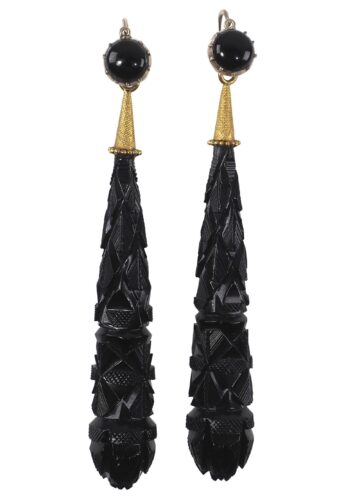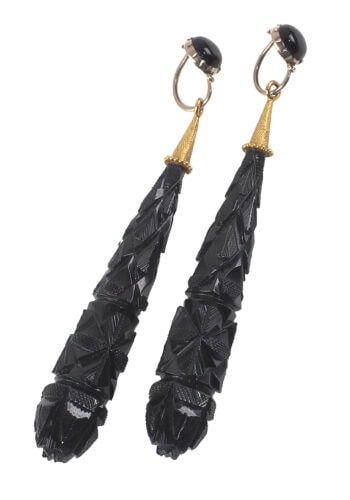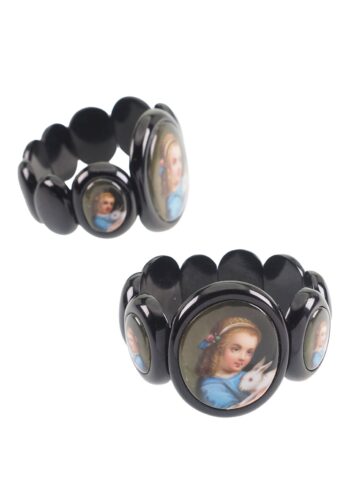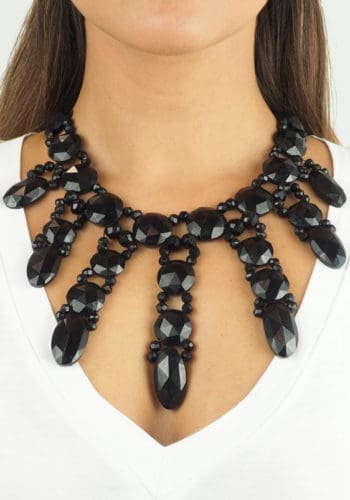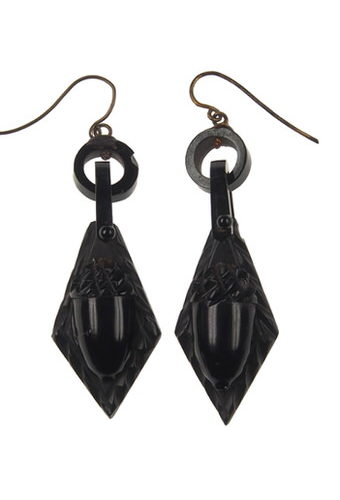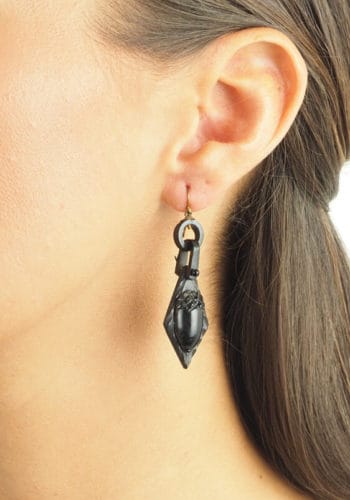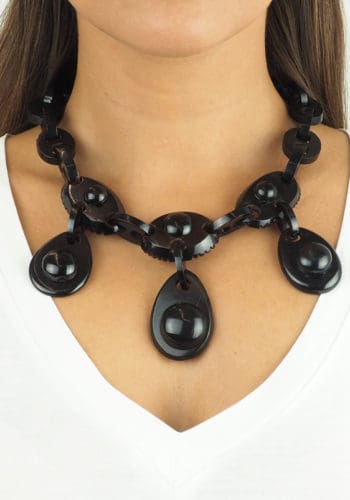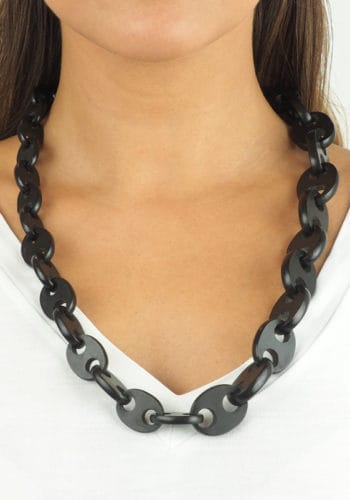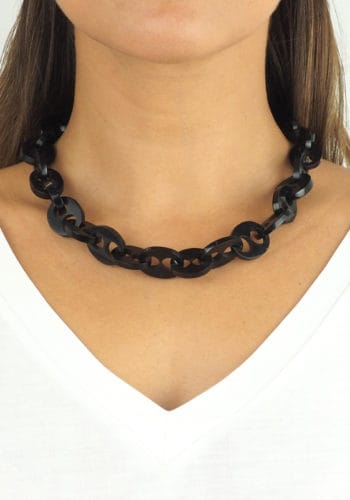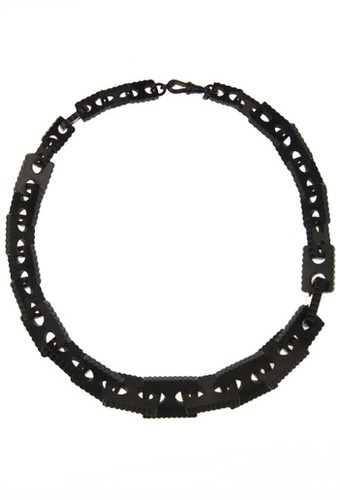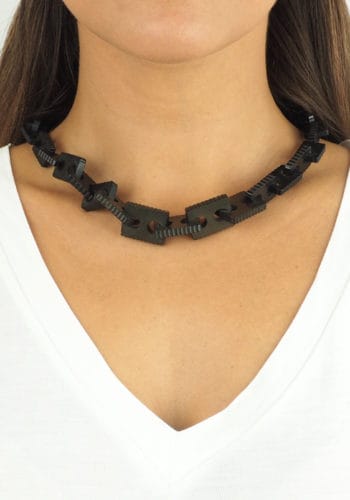
Jet & Vulcanite
Jet was presented at the first World Exhibition in London, the so-called 'Great Exhibition', 1851. This material, which is also known as 'jet' and 'black amber' is a fossilized wood, which is coal in transition from brown coal. This was carved into the desired shape and usually polished. So unique, shiny jewels emerged. Jet jewellery was often also engraved by hand. However, this art required an extreme skill and is rarely found.
In Victorian times came after 1860 by the death of the English Prince Albert mourning jewellery in a kind of ‚fashion‘. At the court wearing black jewellery was henceforth only allowed. As expressions of sympathy and the deep connectedness and devotion to the monarchy, also the people often put on black jewels. Primarily used was the elegant material jet. Since the jewellery production from jet was very complicated and therefore also expensive, but wanted to meet the increased demand and the desire for cheaper versions, vulcanite was an ideal substitute material. Vulcanite consists of rubber, which has been obtained, for example, in East Asia. The practical advantage over jet was that rubber could be casted and therefore the manufacture of larger volumes in less time was possible. Vulcanization is the process of describing the curing of the rubber. Vulcanite is very similar to the look and feel of jet. From jet and vulcanite originated bracelets and bangles, necklaces and chains with pendants in the Victorian era. Furthermore, there were long earrings and brooches, sometimes with silver mounts and decoration. The high degree of skill and detailed handwork still can be seen in the pieces. We think ancient jet jewellery is a very elegant jewellery. The mere association with remembrance jewellery does not do justice to loving creations of old masters. Jet jewellery is extremely proud jewellery! We are pleased to offer you wonderful pieces from the Victorian era in our collection.
Click to fold
In Victorian times came after 1860 by the death of the English Prince Albert mourning jewellery in a kind of ‚fashion‘. At the court wearing black jewellery was henceforth only allowed. As expressions of sympathy and the deep connectedness and devotion to the monarchy, also the people often put on black jewels. Primarily used was the elegant material jet. Since the jewellery production from jet was very complicated and therefore also expensive, but wanted to meet the increased demand and the desire for cheaper versions, vulcanite was an ideal substitute material. Vulcanite consists of rubber, which has been obtained, for example, in East Asia. The practical advantage over jet was that rubber could be casted and therefore the manufacture of larger volumes in less time was possible. Vulcanization is the process of describing the curing of the rubber. Vulcanite is very similar to the look and feel of jet. From jet and vulcanite originated bracelets and bangles, necklaces and chains with pendants in the Victorian era. Furthermore, there were long earrings and brooches, sometimes with silver mounts and decoration. The high degree of skill and detailed handwork still can be seen in the pieces. We think ancient jet jewellery is a very elegant jewellery. The mere association with remembrance jewellery does not do justice to loving creations of old masters. Jet jewellery is extremely proud jewellery! We are pleased to offer you wonderful pieces from the Victorian era in our collection.
Click to fold
-
Ca. 1840 – Hand-carved jet earrings
€ 1.590,00
Differential tax applies collectors items and antiques in accordance with German law §25a UStGFree Shipping -
Ca. 1860 – One Pair Jet Bracelets with Porcelain Paintings
€ 1.490,00
Differential tax applies collectors items and antiques in accordance with German law §25a UStGFree Shipping -
Ca. 1880 – Jet Brooch Victorian England
€ 290,00
Differential tax applies collectors items and antiques in accordance with German law §25a UStGFree Shipping -
Ca. 1860 – Jet Brooch with Cameo Victorian England
€ 390,00
Differential tax applies collectors items and antiques in accordance with German law §25a UStGFree Shipping -
Ca. 1870 – Whitby Jet Earrings, Victorian English
€ 890,00
Differential tax applies collectors items and antiques in accordance with German law §25a UStGFree Shipping -
Ca. 1880 – Jet Necklace Whitbyjet England
€ 890,00
Differential tax applies collectors items and antiques in accordance with German law §25a UStGFree Shipping -
Ca. 1860 – Cut Steel Necklace with Jet-Drops Victorian England
€ 1.490,00
Differential tax applies collectors items and antiques in accordance with German law §25a UStGFree Shipping -
Ca. 1870 – Jet Earrings “Acorn”, Victorian England
€ 490,00
Differential tax applies collectors items and antiques in accordance with German law §25a UStGFree Shipping -
Ca. 1860 – Jet Necklace England
€ 1.290,00
Differential tax applies collectors items and antiques in accordance with German law §25a UStGFree Shipping -
Ca. 1870 – Long Vulcanite chain, from Victorian England
€ 490,00
Differential tax applies collectors items and antiques in accordance with German law §25a UStGFree Shipping -
Ca. 1870 – Whitby-Jet Earrings from Victorian England
€ 690,00
Differential tax applies collectors items and antiques in accordance with German law §25a UStGFree Shipping -
Ca. 1880 – English Whitby Jet Bracelet, mounted on flexible elastic band
€ 290,00
Differential tax applies collectors items and antiques in accordance with German law §25a UStGFree Shipping -
Ca. 1860 – Whitby Jet Earrings, carved and polished, from Victorian England Whitbyjet
€ 790,00
Differential tax applies collectors items and antiques in accordance with German law §25a UStGFree Shipping -
Ca. 1860 – Jet Earrings Victorian England
€ 690,00
Differential tax applies collectors items and antiques in accordance with German law §25a UStGFree Shipping -
Ca. 1860 – Vulcanite Earrings Victorian England
€ 690,00
Differential tax applies collectors items and antiques in accordance with German law §25a UStGFree Shipping -
Ca. 1870 – Vulcanite Necklace with Vulcanite cameo Victorian England
€ 1.290,00
Differential tax applies collectors items and antiques in accordance with German law §25a UStGFree Shipping -
Ca. 1860 – Jet Earrings Whitbyjet Victorian
€ 690,00
Differential tax applies collectors items and antiques in accordance with German law §25a UStGFree Shipping -
Ca. 1870 – Necklace Vulcanite casted Victorian England
€ 490,00
Differential tax applies collectors items and antiques in accordance with German law §25a UStGFree Shipping -
Ca. 1880 – Jet Bracelet with Strass Victorian England
€ 490,00
Differential tax applies collectors items and antiques in accordance with German law §25a UStGFree Shipping -
Ca. 1870 – Jet Necklace Victorian England
€ 590,00
Differential tax applies collectors items and antiques in accordance with German law §25a UStGFree Shipping -
Ca. 1870 – Vulcanite Necklace casted Victorian England
€ 350,00
Differential tax applies collectors items and antiques in accordance with German law §25a UStGFree Shipping




